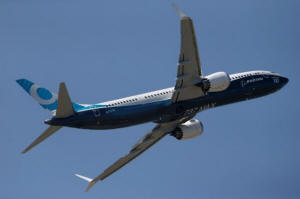|
Boeing lifts 20-year industry demand
forecast to $6 trillion
 Send a link to a friend
Send a link to a friend
 [June 20, 2017]
By Tim Hepher and Victoria Bryan [June 20, 2017]
By Tim Hepher and Victoria Bryan
PARIS (Reuters) - Boeing revised up its
rolling 20-year industry forecast for passenger and freight planes by 4
percent on Tuesday, though signs at the world's biggest air show suggest
a cooling of demand at the moment after years of red-hot growth.
The U.S. planemaker continued to rack up orders at the Paris Airshow for
a new version of its best-selling 737 aircraft, which was launched amid
a flurry of deals.
Leasing firm Aviation Capital Group (ACG), for example, said on Tuesday
it had placed an order for 20 of the new 737 MAX 10 jets, worth a total
of $2.5 billion at list prices.
"It is getting a big endorsement from airlines and that is leading to
more lessors endorsing it too," Ihssane Mounir, Boeing vice president
for sales and marketing, told reporters.
But analysts expect demand at the June 19-25 event to fall short of
recent years, and some aviation companies themselves have cut back staff
and hospitality at the show.
Over the longer-term, though, Boeing sees an industry in rude health,
forecasting 41,030 industry deliveries over the next two decades, up
from 39,620 in a similar projection a year ago and topping $6 trillion
in value.

That includes a five percent increase in the 20-year forecast for
deliveries of single-aisle aircraft like the Boeing 737 and Airbus A320
families, respectively the cash cows of the world's two largest aircraft
manufacturers.
Boeing now expects 29,530 deliveries in the medium-haul single-aisle
category, which is popular with low-cost airlines.
Planemakers also see growing opportunities in aviation services. Boeing
forecast that market could be worth $8.5 trillion over 20 years, growing
at an average 4 percent a year.
Air travel has been on a sharp uptrend, led by emerging economies as
China looks set to replace North America as the world's biggest
transport market in coming years.
But China's growth is now slowing even though it remains above 6 percent
a year. Boeing trimmed its 20-year forecast for average global traffic
growth to 4.7 percent from 4.8 percent.
Airbus took a similar step in its own 20-year forecast released earlier
this month, while increasing the projection for total deliveries by 6
percent, compared with last year's edition, to 34,899 aircraft.
Boeing's overall tally is a bigger number partly because it counts
aircraft with 90 seats or more, whereas Airbus starts at 100 seats.
[to top of second column] |

A Boeing 737 Max takes part in a flying display. REUTERS/Pascal
Rossignol

BIGGER NOT BEST?
In a symbolic change likely to rankle with its European rival,
Boeing ditched its forecast for very large four-engined airplanes
such as the Airbus A380 and its own 747-8.
For the first time, it lumped these together with large two-engined
jets such as the Boeing 777 and largest A350.
Boeing has long argued that the "very large" category is on its way
out as airlines switch to smaller twinjets. Both manufacturers have
had to cut output of four-engined jumbos.
"In fact, frankly, we look at the demand for really big airplanes
and we find it hard to believe that Airbus will be able to deliver
the rest of their A380s in backlog," Marketing Vice-President Randy
Tinseth said in a briefing.
Boeing also expects to deliver only "a handful" of 747-8 passenger
jets.
Airbus insists the double-decker A380 has a future due to airport
congestion and predicts 5 percent of aircraft delivered over the
next 20 years will be very large people carriers or freighters, even
though its forecast has been revised lower.
Despite slower growth in some of the hottest aviation markets,
Boeing said it continued to see "resilient" demand with a long-term
growth trend in traffic of 5 percent a year.
Passenger travel tends to outpace the economy, reflecting growing
numbers of people with some disposable income, while cargo is a
barometer of trade and business confidence.
Boeing predicted demand for 920 cargo planes, down 1 percent from
its previous forecast. Much air cargo nowadays goes in the belly of
wide-body passenger planes rather than freighters.
(Additional reporting by Andrea Shalal, Matthias Blamont, Giulia
Segreti, Mike Stone, and Alwyn Scott in Seattle; Writing by Mark
Potter, editing by David Evans)
[© 2017 Thomson Reuters. All rights
reserved.]
Copyright 2017 Reuters. All rights reserved. This material may not be published,
broadcast, rewritten or redistributed.
 |